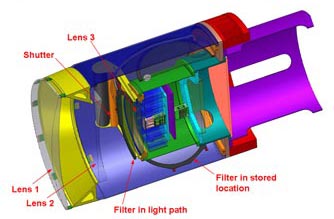
Handy Links
SLAC News Center
SLAC Today
- Subscribe
- Archives: Feb 2006-May 20, 2011
- Archives: May 23, 2011 and later
- Submit Feedback or Story Ideas
- About SLAC Today
SLAC News
Lab News
- Interactions
- Lightsources.org
- ILC NewsLine
- Int'l Science Grid This Week
- Fermilab Today
- Berkeley Lab News
- @brookhaven TODAY
- DOE Pulse
- CERN Courier
- DESY inForm
- US / LHC
SLAC Links
- Emergency
- Safety
- Policy Repository
- Site Entry Form

- Site Maps
- M & O Review
- Computing Status & Calendar
- SLAC Colloquium
- SLACspeak
- SLACspace
- SLAC Logo
- Café Menu
- Flea Market
- Web E-mail
- Marguerite Shuttle
- Discount Commuter Passes
-
Award Reporting Form
- SPIRES
- SciDoc
- Activity Groups
- Library
Stanford
Around the Bay
Step into the World's Largest Digital Camera
(Click for larger image.)
The camera team for the Large Synoptic Survey Telescope will join heads in a three-day workshop the week of September 15th for their last major colloquium before tough agency reviews next spring. A collaboration of 15 institutions and 70 people, the team will review tests of camera element prototypes and explore what’s needed to attain the precision and coordination required for the largest digital camera in the world.
The size of a Smart car and mounted at the center of the telescope’s secondary mirror, the camera employs two lenses to focus light through a filter, shutter and final lens—doubling as a vacuum seal—to the heart of the camera, its detector plane. This 65-centimeter diameter mosaic of silicon detectors dwarfs previous telescope focal planes. It will allow the camera to capture a larger fraction of the sky in one shot than anything in existence. The detectors themselves will address a blind spot in current technology’s view of the electromagnetic spectrum: the transition between infrared and very red visible light, at 9000 Angstroms to 1 micron.
The camera's ability to see into this new discovery space is largely a result of advances in detector efficiency. Only detectors hundreds of microns thick are sensitive to photons at these wavelengths, because the lower energy of red light requires thicker silicon to produce the electron emissions that generate an image. But thick detectors have been avoided because they tend to produce blurriness. The electrons, wandering laterally in the extra silicon, would diffuse before forming the image, creating fuzziness. For LSST, the use of an applied voltage across each detector solves this problem by driving the photoelectrons through the material in tight streams, maintaining a crisp footprint.
In any camera, the lens causes incoming light to converge to a uniform focus across a flat area, or focal plane, where film or detectors can get a clear image. A large aperture to admit more light comes with a strict optical tradeoff in the form of shallower depth of focus, meaning the detectors must lie within a very shallow, flat rectangle. In the LSST detecting plane, flatness deviations as small as 10 microns peak-to-peak will degrade the focus. But the size of this image surface is enormous, making the necessary stability very difficult to achieve. Currently, LSST scientists are working to minimize even the slightest movement of individual detectors that could result from gravity and mechanical motion.
The next key challenge is to achieve uniformity in the curved filter's coating, critical for getting each color of light to converge at the same point. Variations greater than 1 percent in coating thickness will cause incoming light's wavelengths to shift in the filter, degrading image quality. But at the moment, manufacturers find it nearly impossible to deposit so many filter coatings with the necessary accuracy across a curved surface.
These puzzles and more will be under discussion at the September camera team meeting. When all of the pieces are in place, the camera will have unique potential to peer into the antics of dark energy and dark matter. Studies of weak lensing, the distortion of visible light by the gravitational effects of dark matter, are rare because examples are sparse in typical telescope images. The LSST will record and catalogue hundreds of examples of weak lensing, to a precision that will enable statistically stronger analyses. The results could help explain the expansion of the universe and the nature of dark energy and dark matter. Scientists and anateur astronomers alike will be able to explore the data; the LSST collaboration plans to make its continuously updating, high-definition color images available to the world online, essentially creating a deep space, non-virtual version of Google Sky.
—Zoë Macintosh
SLAC Today, August 25, 2008
